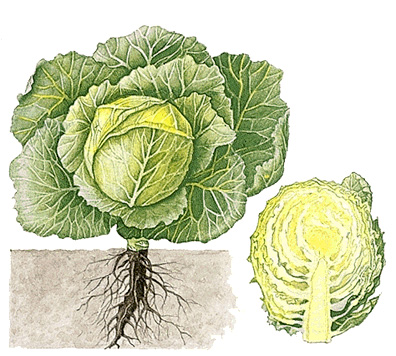Cabbage is a common vegetable native to England and northwestern France, but grown throughout Europe, Asia, and North and South America. Other leafy vegetables closely related to the cabbage include cauliflower, Brussels sprouts, broccoli, and turnips.

Kinds of cabbage.
There are three kinds of cabbage, white, red, and savoy. The leaves of the plant grow close together to form a hard, round head. The leaves of the white and red cabbage are usually smooth but have prominent veins. Those of the savoy appear wrinkled or blistered. White cabbage, which has pale green leaves, is the most popular type in the United States. People eat it raw in salads, cooked as a hot vegetable, or pickled as sauerkraut . Red cabbage, with its reddish-purple leaves, is not so popular as the white, but it can be eaten raw or cooked. The savoy type has a milder flavor. Chinese cabbage, also called celery cabbage, is not a true cabbage. Its long, thin leaves form stalks similar to celery.
Cultivation.
Cabbage grown commercially under normal conditions is a biennial. Seed producers grow the plants one year and leave them in the ground during winter. In the spring, the plants produce seed. Sometimes cabbage plants subjected to cool weather (50 to 55 °F, or 10 to 13 °C) produce flowers and seeds prematurely and do not yield marketable heads. This is called bolting. However, plant breeders have developed varieties that are resistant to cold temperatures.
Cabbage seeds are small and look almost exactly like those of cauliflower, broccoli, or other similar plants. In regions with a mild climate, most farmers prefer to plant the seed directly in the field. They sow the seed in rows about 3 feet (91 centimeters) apart. When the young plants grow, workers thin the rows to allow a space of about 18 to 24 inches (46 to 61 centimeters) between the plants.
In regions with short growing seasons, farmers may start the seeds in a greenhouse or hotbed. They plant the seeds in small, shallow boxes called flats. Shortly after the seedlings sprout, workers transplant them to larger flats, spacing them 2 inches (5 centimeters) apart. The plants grow for another 4 to 6 weeks, then workers transplant them to the field. However, each plant must reestablish itself every time it is transplanted, so transplanting retards growth. Therefore, most farmers, particularly those in mild climates, seed cabbage directly in the field. Field seeding is much less expensive than transplanting. Also, seedlings establish a better root system than do transplanted cabbage plants. But transplanting is a more reliable method of growing. Home gardeners often prefer to buy the small plants.
Insects and diseases.
Cabbage plants are attacked by aphids, cabbage loopers, maggots, cabbageworms, and other insects. Some insects eat the leaves, destroying the head’s shape. Insecticides can control insects.
Diseases that affect cabbage plants include blackleg, club root, mildew, mosaic, black rot, and yellows. Club root and yellows are soilborne diseases. Scientists have developed cabbage varieties resistant to yellows.
